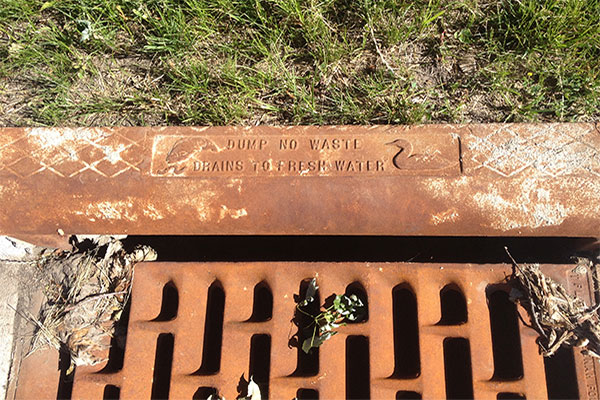What flows in, also flows out

As the snow starts melting this month, snowmelt will rush off your yard in all directions. If you live in an urban area, the snow melt will likely find its way to the nearest storm drain. Storm drains collect and channel snow melt and rain runoff into a series of underground stormwater pipes that send the water to the nearest lake, river or pond.
What flows into storm drains, often flows out the other side and into lakes, rivers or ponds. This runoff is not treated like the wastewater from your house. Wastewater from sinks, showers and toilets drains and goes to wastewater treatment facilities for cleaning. Stormwater runoff does not. Many cities have created raingardens, stormwater ponds and other practices to help filter pollutants from stormwater runoff. These practices greatly help to protect lakes and river by removing phosphorus and sediment from stormwater. However, they are not designed to remove chemicals such as paint, soap, trash or other pollutants.
Too frequently, storm drains are treated like sinks or garbage cans. In my own neighborhood, I’ve seen people throw cigarette butts into them and dump buckets of soapy water down them. These actions aren’t only unsafe and polluting, they are illegal. Only the water that falls from the sky, such as rain or melted snow, can flow into a storm drain. Anything else entering a storm drain is an illicit discharge.
There are many types of illicit discharges. Some you may not think of as pollutants, such as grass clippings, leaves, salt from sidewalk de-icers, soil, dog waste, soapy water, and chlorinated pool water. These cause problems in water such as algae blooms, bacteria, low dissolved oxygen levels and affect wildlife. Then there are some pollutants that more obviously don’t belong flowing into storm drains such as paint, motor oils, trash, lawn chemicals, or septic tank discharge.
If you suspect an illicit discharge, observe but don’t get too close. Don’t touch or smell the substance. Instead, contact your city with your observations and the location. A non-emergency police line can be used if its outside of business day hours. Make sure you are ready to provide the following information.
-
- You name and contact info.
- Time, date and location of the discovery.
- Description of the material, if you know the source
- The extent of the program (major flow verses little trickle)
- Take photos
Allow only rain down the drain and protect lakes, rivers and ponds in your neighborhood. You can go a step further by adopting a storm drain in your neighborhood. The Adopt a Drain program launched in Minnesota last year. Over 10,000 storm drains have been adopted so far and the program has prevented over 180,000 lbs. of debris from washing into our waters. Learn more at www.adopt-a-drain.org.
Pledge to Keep our water
Drinkable, Fishable, Swimmable
Pledge and Play!
Take the pledge and download our Clean Water BINGO. Play to help keep our water clean.

